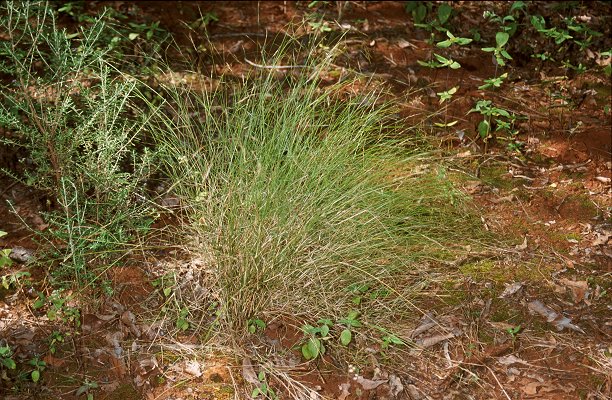 |
 |
|
 |
 |
|

Aristida gracilipes (Domin) Henrard |
Derivation
Aristida L., Sp. Pl. 1: 82 (1753); from the Latin arista
(an awn).
gracilipes- from the Latin gracilis (slender) and pes (foot),
alluding to the fine and bushy habit.
Published in
Meded. Rijks. Herb. Leiden 54: 209 (1926).
Common synonyms
Aristida vagans Cav. var. gracillima Benth.
Habit
Perennial, tufted. Culms geniculately ascending, 60–115 cm tall. Mid-culm
internodes smooth or scaberulous, glabrous. Lateral branches branched or fastigiate.
Leaf-sheaths smooth or scaberulous, glabrous on surface. Ligule a fringe of
hairs, 0.5 mm long. Collar glabrous. Leaf-blades straight, conduplicate or involute
or convolute, 4–8 cm long, 0.5 mm wide. Leaf-blade surface scabrous.
Inflorescence
Inflorescence compound, a panicle. Panicle open, linear, 12–21 cm long,
1–3 cm wide. Primary panicle branches appressed, moderately spaced, 4–6
cm long. Panicle branches with insignificant pulvini.
Spikelets
Spikelets solitary. Fertile spikelets 1-flowered, comprising 1 fertile floret,
without rhachilla extension, lanceolate, terete, 8–11 mm long, breaking
up at maturity. Spikelets disarticulating below each fertile floret. Floret
callus elongated, pubescent, acute.
Glumes
Glumes persistent, similar, thinner than fertile lemma. Lower glume lanceolate,
4–10 mm long, equalling upper glume, membranous, 1-keeled, 1-nerved.
Lower glume lateral nerves absent. Lower glume surface smooth to scabrous. Lower
glume apex acuminate, mucronate. Upper glume lanceolate, 4–10 mm long,
50–90% of length of adjacent fertile lemma, membranous, 1-keeled, 1-nerved.
Upper glume lateral nerves absent. Upper glume apex entire or erose, emarginate,
mucronate.
Florets
Fertile lemma lanceolate, subterete, 8–11 mm long, coriaceous, pallid or
light brown, 3-nerved. Lemma midnerve scabrous. Lemma surface scabrous, rough
on nerves. Lemma margins convolute, covering most of palea. Lemma apex acute,
3-awned. Median (principal) awn spreading, 10–20 mm long, without a column,
persistent. Lateral lemma awns present, spreading as much as principal, 10–16
mm long, subequal to principal or shorter than principal, 90–100% of
length of principal. Palea 20% of length of lemma, without keels. Anthers
3. Grain with adherent pericarp, terete, not grooved, 6–8 mm long. Embryo
40–60% of length of grain. Hilum linear, 50% of length of caryopsis.
Continental Distribution:
Australasia.
Australian Distribution:
Queensland, New South Wales.
Queensland: Cook, Burke, North Kennedy, South Kennedy, Port Curtis, Leichhardt, Burnett, Wide Bay, Darling Downs, Moreton, Mitchell, Maranoa. New South Wales: North Coast.
Classification. (GPWG
2001):
Aristidoideae
Notes
Native. Mainly Queensland with one record from northern New South Wales. Acacia,
brigalow (Acacia harpophylla), Eucalyptus communities, and rainforest
fringes, on clays, loams and sandy soils. Flowering and fruiting all year but
mainly January to July. Aristida gracilipes has longer inflorescences
without pulvini and has slightly longer glumes than Aristida caput-medusae
and Aristida vagans, and is loosely tufted with bushy culms with many
fine branches. Chapman (1991) is correct in stating that Lazarides (1980) is
wrong in treating this as a sp. nov. (actually a nom. nov.) by Henrard as it
is based on the same type as Domin's variety.

Habit (photo)
© Queensland Herbarium
Sharp 339 and Simon
by D.Sharp